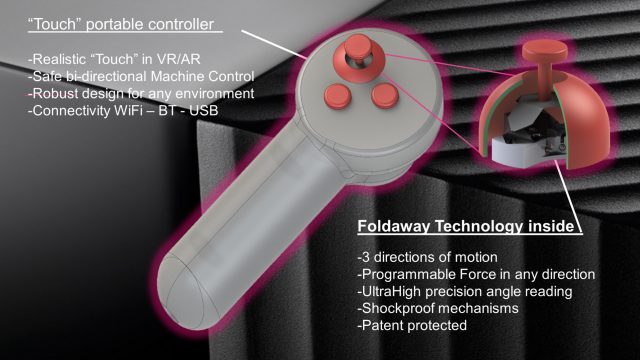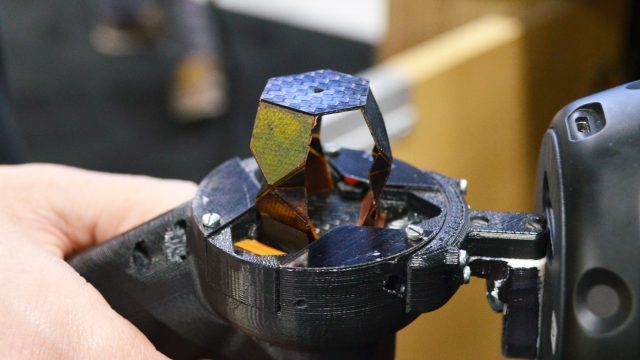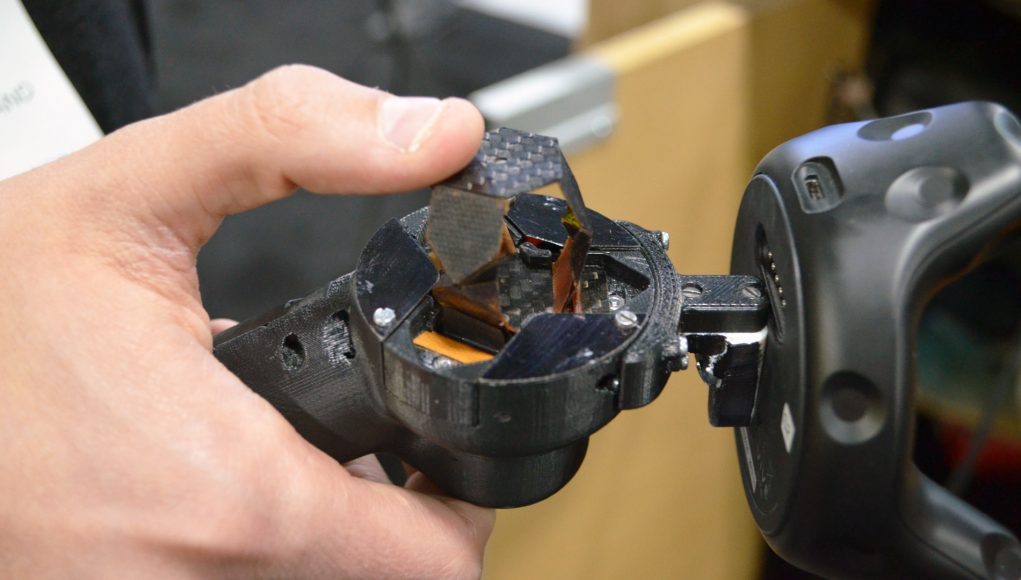Switzerland-based Foldaway Haptics is building a haptic joystick with force feedback. The impressive device, which can push back against your finger in any direction, could bring rich feedback to VR controllers at reasonable costs.
Over the years we’ve seen some really awesome haptic tech, like the HaptX glove that offers compelling tactile sensations and force-feedback on all five fingers. But it’ll take something simple and low cost to have any chance of finding its way into the consumer VR space which is currently dominated by controllers—which are rapidly converging on thumbsticks as the primary input mechanism (aside from motion).
That makes Foldaway Haptics’ solution quite interesting. The company is building what’s effectively a tiny three legged platform than can move and tilt in any direction. They’re adapting the mechanism to function as a joystick which offers force-feedback. At CES 2019 this week the company showed off a prototype VR controller with the mechanism built-in.
I tried the prototype running with a Vive headset and a small demo game that Foldaway built. In the game I saw a miniature cartoon farm in front of me at waist height; a few different animals were running around on the ground. When I reached out to grab an animal, I pushed down on the thumbstick to ‘grip’ the animal between my hand and my thumb. Upon grabbing the animal, the thumbstick became stiff (letting me know that I had successful grabbed something).
Each animal had somewhat different haptic properties. The pig, for instance, was a little bit ‘squishy’, allowing me to push my thumb down on the stick a bit. The penguin was ‘harder’ so the thumbstick resisted my thumb much more. If I squeezed too hard, the force-feedback would give out and the thumbstick would bottom out until I let go (I expect this is to protect the motors and mechanism from damage).
Co-founder Marco Salerno told me that the current prototype is capable of pushing back with two newtons (about the force of two apples resting on your hand), though they could feasibly push upward of 15 newtons with some different design tradeoffs.
Beyond force-feedback just in the up and down direction, the joystick can also tilt itself against your finger rather than just pushing back. This allows directional information to be conveyed to you through touch, which is a big deal because the simple vibrating haptics in any consumer controller (VR or otherwise) cannot convey arbitrary directional information.

The ‘platform’ of the mechanism of course didn’t feel quite like a traditional thumbstick because of the way that it pivots differently and because of its shape. However, Salerno says that the current prototype is designed to show the mechanism, but a more mature design could replicate a thumbstick much more closely in both look and feel.
The feedback offered by Foldaway is still largely an abstraction, just like vibration, but even if it’s not explicitly ‘realistic’, it can offer much richer information about the virtual world, which has the potential to add to immersion.
In describing the Foldaway thumbstick, Salerno told me that the mechanism is effectively a tiny “robot,” in the sense that it can be directed to execute precise movements and also use the force from the user as input to inform its motions . The mechanism, he said, is fundamentally designed after a ‘delta robot’, but the company’s innovation is the ability to make it very small while maintaining a wide range of motion, achieved through an “origami-like” construction.

According to the Foldaway website, Salerno holds a Ph.D in robotics and worked for three years as a researcher at the Reconfigurable Robotics Lab at École Polytechnique Fédérale de Lausanne, a Swiss university. Salerno’s co-founder, Stefano Mintchev, holds patents for “foldable systems,” and also worked as a researcher at the same lab as Salerno.
Salerno told me that Foldaway has received around $500,000 in grants and is in the process of raising a $2 million seed investment.







